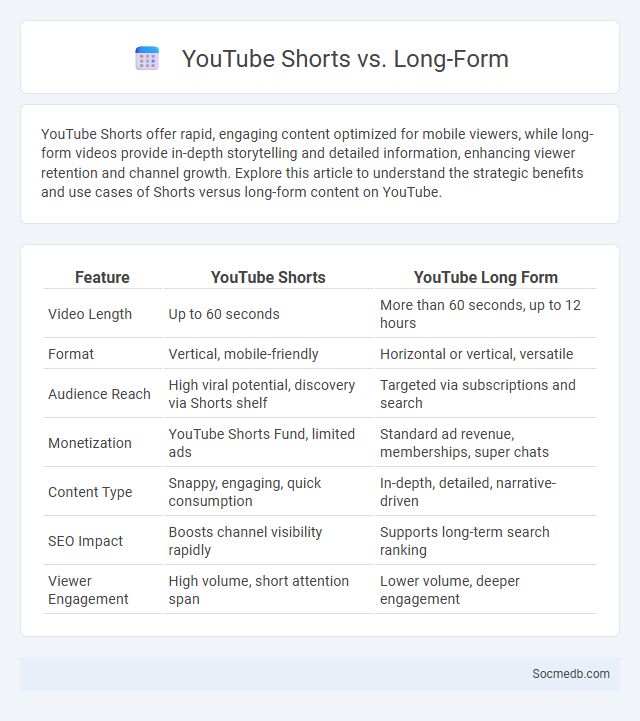
Photo illustration: YouTube Shorts vs Long Form
YouTube Shorts offer rapid, engaging content optimized for mobile viewers, while long-form videos provide in-depth storytelling and detailed information, enhancing viewer retention and channel growth. Explore this article to understand the strategic benefits and use cases of Shorts versus long-form content on YouTube.
Table of Comparison
| Feature | YouTube Shorts | YouTube Long Form |
|---|---|---|
| Video Length | Up to 60 seconds | More than 60 seconds, up to 12 hours |
| Format | Vertical, mobile-friendly | Horizontal or vertical, versatile |
| Audience Reach | High viral potential, discovery via Shorts shelf | Targeted via subscriptions and search |
| Monetization | YouTube Shorts Fund, limited ads | Standard ad revenue, memberships, super chats |
| Content Type | Snappy, engaging, quick consumption | In-depth, detailed, narrative-driven |
| SEO Impact | Boosts channel visibility rapidly | Supports long-term search ranking |
| Viewer Engagement | High volume, short attention span | Lower volume, deeper engagement |
Introduction to YouTube Shorts and Long-Form Content
YouTube Shorts offers bite-sized videos up to 60 seconds, designed for quick, engaging viewing on mobile devices, perfect for capturing trends and boosting visibility. Long-form content on YouTube allows creators to dive deeper into topics, fostering stronger audience engagement and watch time, essential for growing your channel's authority. Balancing both formats can optimize your reach and retain diverse viewers on the platform.
Key Differences Between YouTube Shorts and Long-Form Videos
YouTube Shorts are brief, vertical videos under 60 seconds designed for quick, mobile-friendly consumption, while long-form videos typically last several minutes and offer more in-depth content. Shorts emphasize rapid engagement and viral potential through algorithm-driven discovery, whereas long-form videos focus on detailed storytelling, monetization opportunities, and audience retention. Your content strategy should align with these differences to maximize reach and viewer interaction on YouTube.
Audience Engagement: Shorts vs. Long-Form Content
Shorts on platforms like YouTube and TikTok captivate Your audience through quick, visually dynamic clips, driving high retention and frequent interactions. Long-form content fosters deeper storytelling and educational value, encouraging sustained engagement and community building around topics. Balancing both formats leverages diverse viewer preferences, maximizing Your reach and interaction rates across social media channels.
Algorithm and Discovery: How YouTube Promotes Each Format
YouTube's algorithm prioritizes viewer engagement metrics such as watch time, click-through rate, and audience retention to promote videos across formats like Shorts, standard uploads, and live streams. Discovery mechanisms differ, with Shorts benefiting from a dedicated shelf and autoplay features, while traditional videos rely on personalized recommendations and search rankings. Understanding these platform-specific promotional strategies enables creators to optimize content format and metadata for maximum visibility and growth.
Monetization Opportunities: Shorts vs. Long-Form Videos
Monetization opportunities on social media vary significantly between Shorts and long-form videos, with Shorts generating revenue primarily through ad shares based on views, while long-form videos offer diverse income streams including ads, sponsorships, and subscriber memberships. You can capitalize on Shorts' rapid viewer engagement to boost immediate earnings, whereas long-form content builds deeper audience connections that enhance long-term revenue potential. Understanding the distinct monetization models allows you to strategically optimize your content for maximum profitability.
Content Creation Strategies for Shorts and Long-Form
Effective content creation strategies for social media differentiate between Shorts and Long-Form formats by tailoring engagement techniques. Shorts thrive on concise, visually striking messages with strong hooks in the first seconds, optimal for platforms like TikTok and Instagram Reels. Long-Form content benefits from detailed storytelling, educational value, and consistent branding to build deeper audience relationships on YouTube and Facebook.
Pros and Cons of YouTube Shorts
YouTube Shorts offers creators a powerful platform to expand their audience quickly through short, engaging videos optimized for mobile viewing, increasing visibility and potential subscriber growth. However, the limited video length might restrict in-depth content, and the algorithm-driven feed can lead to inconsistent exposure, which may impact your reach and engagement over time. Balancing these advantages and limitations helps you effectively leverage YouTube Shorts to complement your broader social media strategy.
Pros and Cons of YouTube Long-Form Videos
YouTube long-form videos offer creators opportunities to engage audiences with in-depth content, enhancing viewer retention and boosting ad revenue through longer watch times. However, producing extended videos requires significant time and resources, and lengthy content may deter users with limited attention spans or slower internet connections. The platform's algorithm favors watch time, benefiting long-form creators, but competition for viewer engagement remains intense.
When to Use Shorts, Long-Form, or Both
Shorts are ideal for capturing quick attention and engaging viewers with concise, impactful content, boosting brand visibility in algorithms favoring brief videos. Long-form content excels in delivering in-depth information, storytelling, and building a loyal audience through detailed exploration of topics or tutorials. Combining both formats maximizes reach and engagement by catering to diverse viewer preferences and platform algorithms, enhancing overall social media strategy effectiveness.
Future Trends: The Evolving Landscape of YouTube Content
YouTube content is rapidly evolving with the integration of artificial intelligence and virtual reality, enhancing interactive and immersive viewer experiences. Short-form videos and live streaming continue to dominate, driven by shifting user preferences and increased mobile consumption. Creators are leveraging data analytics to optimize content strategies, ensuring higher engagement and personalized recommendations in the ever-changing social media ecosystem.
 socmedb.com
socmedb.com